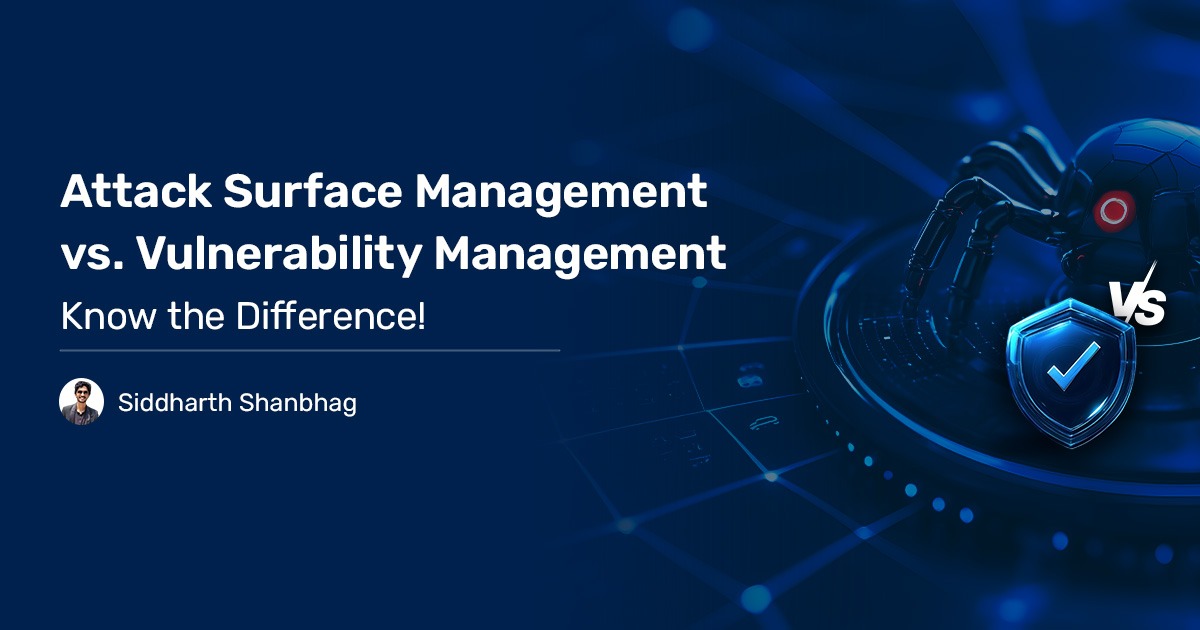Attack surface management and Vulnerability Management have always been mistaken. Knowing the difference between managing your attack surface and managing vulnerabilities is key. These two terms may sound familiar, but each tackles a different aspect of security. So, let’s dive into the world of attack surface management (ASM) vs vulnerability management (VM) to unravel what they mean and how they work together to safeguard your enterprise’s IT.
Understanding the basics
What is Attack Surface Management?
Think of your attack surface like the front door, windows, and other access points into your digital house. Attack surface management is about identifying and tracking each one of those endpoints. It’s all about visibility. You need to see all the ways a hacker could try to break in, whether it’s through servers, apps, or even IoT devices. ASM helps you know what’s out there, known and unknown assets alike.
ASM focuses on mapping every endpoint of exposure across your infrastructure, including anything connected to the internet, cloud services, or internal systems that could be exploited.
What is Vulnerability Management?
Now, think of vulnerability management as your defense system once the potential entry points are spotted. Vulnerability management identifies weaknesses in your system, like missing patches and misconfigurations, and helps you patch them before attackers try to get inside.
Vulnerability Management doesn’t just stop at discovering vulnerabilities. It continuously monitors, assesses, prioritizes, and remediates the risks. It’s the proactive measure that keeps your systems safe by keeping your defenses up to date.
Key Difference Between Attack Surface Management & Vulnerability Management
While both attack surface management and vulnerability management are crucial parts of cybersecurity, they aren’t the same thing. Let’s break down the differences!
| Aspect | Attack Surface Management | Vulnerability Management |
| Primary Focus | Identifying and mapping external and internal attack points | Finding, assessing, and fixing system vulnerabilities |
| Scope | Broad view of assets, including unknown and shadow IT | Narrow focus on known vulnerabilities within identified assets |
| Action | Discovery and visibility of risks | Mitigation and remediation of specific vulnerabilities |
| Frequency | Continuous monitoring for new entry points | Periodic scanning and patching of vulnerabilities |
| Goal | Reduce exposure by controlling access points | Reduce risks by patching weaknesses in the system |
To sum it up, ASM is like knowing every door and window in your house, while VM is making sure those doors and windows have secure locks.
ASM, let’s you know what’s out there, while VM helps you fix what’s weak.
Attack Surface Management vs Vulnerability Management: The Process
Attack surface management process
The ASM process revolves around continuous discovery and mapping of your digital assets. It typically follows these steps:
- Asset Discovery: Identify all known and unknown assets, including IPs, domains, cloud services, and devices.
- Risk Assessment: Determine how these assets could be exploited.
- Prioritization: Rank the entry points based on their risk level.
- Monitoring: Continuously track new or changed assets and potential risks.
The key here is “Visibility”. ASM gives you a complete map of every possible entry point a hacker might exploit.
Vulnerability management process
The VM process focuses more on the assessment and remediation of the known risks:
- Vulnerability Scanning: Regularly scan systems, networks, and apps to find weaknesses.
- Assessment: Determine the severity of the vulnerabilities found.
- Prioritization: Prioritize vulnerabilities based on their criticality and potential impact.
- Remediation: Fix the vulnerabilities by patching software, updating configurations, or deploying fixes.
- Reporting: Ensure the fixes have been applied successfully and generate reports.
VM is all about “fixing” what’s broken, whereas ASM focuses on “discovering” all the potential cracks.
Best way to implement ASM and VM: The SanerNow Way
- See Everything: Manage vulnerabilities, exposures, and other security risks in a single unified dashboard. It offers a centralized console where both IT and security teams collaborate. Both the teams access the same information, track progress, and communicate effectively.
- Prioritization of Risks: The vulnerabilities are prioritized into Act, Attend, Track and Track*. Both teams work together to prioritize vulnerabilities based on their potential impact on the operations and security.
- Real time visibility: Access real-time visibility into the company’s security posture and IT. Both teams can access up-to-date information about the security vulnerabilities, asset inventory, patch status, and compliance posture, enabling them to make informed decisions together.
- Customizable Reports: Create customized reports tailored to your specific requirements. These reports provide insights into key metrics and KPIs, clearing the way for communication and alignment between teams.
- Integrated Patch Management: Collaborate on patching risks with integrated patch management solution. Both security and IT teams can collaborate and ensure the vulnerabilities are detected and patched immediately or schedule patches during off hours to ensure the company’s business is not disrupted.
- Meet Compliant Standards: Automate and streamline compliance management with SanerNow. Security and IT teams can ensure the companies compliance standards are up to date by regulating their IT devices with HIPAA, PCI, ISO, NIST CSF, and STIG compliance benchmarks.
Conclusion
Attack surface management and vulnerability management together form a powerful defense against cyber threats. SanerNow lets you gain real-time visibility, proactive risk reduction, and collaboration between IT and security teams. The result? A secure, streamlined, and compliant system that reduces your exposures and keeps attackers at bay. Remember, knowing where you’re exposed is half in the battle, patching up those weak spots is the other.


